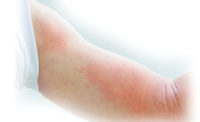When your skin doesn’t protect…
Inhalation exposures are not the only threat

Occupational skin diseases (OSD) are common and costly. They represent the second most common type of occupational illness and include irritant contact dermatitis, allergic contact dermatitis, skin cancers and skin infections. Just one OSD — contact dermatitis – has estimated annual costs of more than $1 billion. Plus, health problems caused by toxins absorbed through the skin can be more than skin deep; dermal exposure to hazardous agents can enter the blood stream and affect other parts of the body.1
Despite this, efforts to minimize workers’ exposure to toxins have long focused mainly on the inhalation route. Fortunately, NIOSH has developed a hierarchy of controls to reduce dermal exposure.
Who is at risk?
NIOSH estimates that more than 13 million workers in the U.S. are potentially exposed to chemicals that can be absorbed through the skin. Workers risk potentially harmful exposures of the skin in industries including food service, cosmetology, health care, agriculture, cleaning, painting, mechanics, printing/lithography and construction.
Contact dermatitis, also called eczema, is the most commonly reported form of OSD, constituting approximately 90-95 percent of all cases of OSD in the U.S. Defined as an inflammation of the skin resulting from exposure to a hazardous agent, its symptoms include itching, pain, redness, swelling, and the formation of blisters or dry, flaking scaly areas on the skin.2
How exposure occurs
Exposure can be caused by direct contact, aerosols, immersion or splashes. Dermal absorption — which can occur without the worker even noticing it — happens when a chemical travels from the outer surface of the skin both into the skin and into the body. The outer layer of the skin — called the stratum corneum (SC) – acts as a protective barrier, so the thickness and general health of the SC (whether or not it’s damaged, for instance) are important factors in whether absorption occurs and in the rate at which it occurs.1
The physical and chemical properties of the hazardous substance, the concentration of the chemical on the skin’s surface and the duration of the exposure also have a role in absorption.1
Chemical agents are the main cause of occupational skin diseases and disorders. Primary or direct irritants cause a chemical reaction directly on the skin. Others — called sensitizers — result in allergic reactions after repeated exposure.
Pesticides and organic solvents pose a special danger. They may result in systemic toxicity if they penetrate through the skin and enter the blood stream.
How to prevent exposure
When possible, you should attempt to replace the hazardous agent with a less hazardous compound. Engineering controls such as local exhaust ventilation systems and isolation booths can be used to prevent hazardous agents from contacting workers’ skin. Next in the hierarchy of controls2 are administrative controls, such as training programs that educate workers about chemical hazards and how they can protect themselves from those hazards.
Finally, NIOSH says that personal protective equipment — gloves, safety glasses, protective clothing and boots — should be worn by workers who:
- Clean and disinfect tools, equipment and work areas
- Come into contact with solvents, glue or epoxy resins or
- Come into contact with preparations containing soaps, detergents and disinfectants.
Looking for a reprint of this article?
From high-res PDFs to custom plaques, order your copy today!






